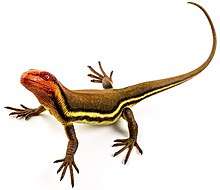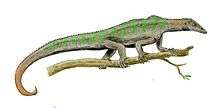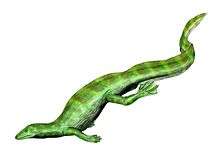Euconcordia
Euconcordia is an extinct genus of Late Carboniferous captorhinid known from Greenwood County, Kansas of the United States.[1]
| Euconcordia | |
|---|---|
| Scientific classification | |
| Kingdom: | Animalia |
| Phylum: | Chordata |
| Class: | Reptilia |
| Family: | †Captorhinidae |
| Genus: | †Euconcordia Reisz, Haridy & Müller, 2016 |
| Species: | †E. cunninghami |
| Binomial name | |
| †Euconcordia cunninghami (Müller & Reisz, 2005) | |
Description
Euconcordia is known from the holotype KUVP 8702a&b, well preserved skull in dorsal view along with its counterpart, a partial preserved braincase in ventral view, and from the referred specimen KUVP 96/95, well preserved skull in ventral view and a poorly preserved dorsal counterpart. It was collected in the Hamilton Quarry, from the Calhouns Shale Formation of the Shawnee Group, dating to the Virgilian stage (or alternatively late Kasimovian to early Gzhelian stage) of the Late Pennsylvanian Series, about 300 million years ago. Euconcordia was originally thought to be the basalmost known member of Captorhinidae.[1] A novel phylogenic study of primitive reptile relationships by Müller & Reisz in 2006 recovered Thuringothyris as a sister taxon of the Captorhinidae, and therefore, by definition, Thuringothyris represents the basalmost known captorhinid.[2] The same results were obtained in later phylogenic analyses.[3][4] Euconcordia is still the earliest known captorhinid as all other captorhinid taxa are known only from Permian deposits.[2]
Etymology
Euconcordia was first named by Johannes Müller and Robert R. Reisz in 2005. Its original generic name was Concordia and the type species is Concordia cunninghami. The original generic name was derived from the Latin concordia, meaning "unity" or "harmony". The specific name honors Christopher R. Cunningham for studying this taxon as part of his PhD thesis on the Hamilton Quarry.[1] The original generic name turned out to be preoccupied by extant hippolytid crustacean Concordia Kingsley, 1880 (currently considered a junior synonym of Latreutes Stimpson, 1860). Reisz, Haridy & Müller (2016) coined a replacement name Euconcordia.[5]
References
- Johannes Müller and Robert R. Reisz (2005). "An early captorhinid reptile (Amniota, Eureptilia) from the Upper Carboniferous of Hamilton, Kansas" (PDF). Journal of Vertebrate Paleontology. 25 (3): 561–568. doi:10.1671/0272-4634(2005)025[0561:AECRAE]2.0.CO;2.CS1 maint: uses authors parameter (link)
- Muller, J. and Reisz, R.R. (2006). "The phylogeny of early eureptiles: Comparing parsimony and Bayesian approaches in the investigation of a basal fossil clade." Systematic Biology, 55(3):503-511. doi:10.1080/10635150600755396
- Robert R. Reisz; Jun Liu; Jin-Ling Li; Johannes Müller (2011). "A new captorhinid reptile, Gansurhinus qingtoushanensis, gen. et sp. nov., from the Permian of China". Naturwissenschaften. 98 (5): 435–441. doi:10.1007/s00114-011-0793-0. PMID 21484260.
- Sumida, S.S.; Dodick, J.; Metcalf, A.; Albright, G. (2010). "Reiszorhinus olsoni, a new single-tooth-rowed captorhinid reptile of the Lower Permian of Texas". Journal of Vertebrate Paleontology. 30 (3): 704–714. doi:10.1080/02724631003758078.
- Robert R. Reisz; Yara Haridy; Johannes Müller (2016). "Euconcordia nom. nov., a replacement name for the captorhinid eureptile Concordia Müller and Reisz, 2005 (non Kingsley, 1880), with new data on its dentition". Vertebrate Anatomy Morphology Palaeontology. 3: 1–6. doi:10.18435/B53W22.




